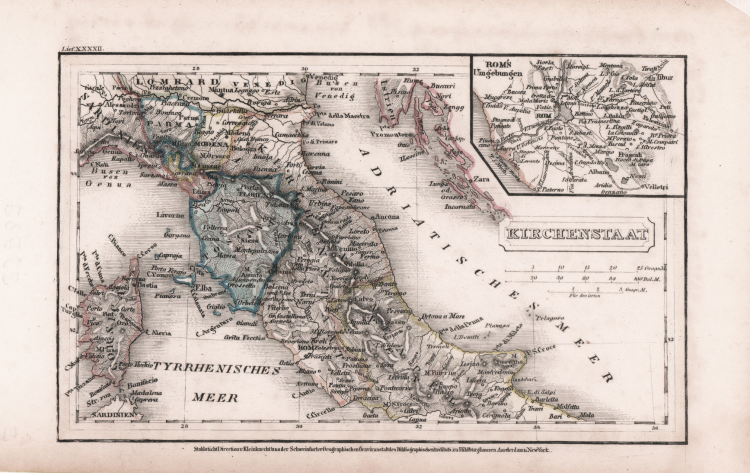



| Reference: | CO-583 |
| Author | Carl Joseph MEYER |
| Year: | 1830 ca. |
| Zone: | Central Italy |
| Printed: | Hildburghausen |
| Measures: | 180 x 110 mm |


| Reference: | CO-583 |
| Author | Carl Joseph MEYER |
| Year: | 1830 ca. |
| Zone: | Central Italy |
| Printed: | Hildburghausen |
| Measures: | 180 x 110 mm |
Carta geografica dello Stato della Chiesa con la Toscana. Nel riquadro in alto a destra un particolare della zona di Roma.
Stampata a Hildeburghausen dal Bibliographisches Institut.
Fondata nel 1826 a Gotha da Joseph Meyer, nel corso degli anni ha pubblicato molte importanti opere, tra cui la grande enciclopedia Meyers Konversations-Lexikon, la serie di libri di viaggio Meyers Reisebücher (pubblicata tra il 1832 e il 1936), i dizionari e saggi linguistici Duden (dal 1880), la collana di letteratura tedesca e straniera Meyers Klassiker, gli atlanti Meyers Handatlas e Der Grosse Meyers Weltatlas, e altre. La sede della società fu quasi completamente distrutta nel 1943/44 dai bombardamenti aerei sulla città di Lipsia. Nel 1946 fu espropriata dal regime comunista della Germania Est e nel 1953 gli azionisti trasferirono la società a Mannheim, nella Germania Occidentale. Nel 1984 la società "Bibliographisches Institut AG" si fuse con la sua maggiore concorrente nel settore dell'editoria enciclopedica, la "F. A. Brockhaus" di Wiesbaden, formando la società "Bibliographisches Institut & F.A. Brockhaus AG", con sede a Mannheim. Nel 1991, dopo la riunificazione della Germania, la società tornò in possesso di quanto era rimasto a Lipsia e trasferì la sede a Berlino.
Carl Joseph MEYER (Gotha, 1796 – Hildburghausen, 1856)
|
Carl Joseph Meyer (9 May 1796 - 27 June 1856) was a German industrialist and publisher, most noted for his encyclopaedia, Meyers Konversations-Lexikon.
Meyer was born at Gotha, Germany, and was educated as a merchant in Frankfurt am Main. He went to London in 1816, but returned to Germany in 1820 after business adventures and stock speculations fell through. Here he invested in enterprises such as the textile trade (1820–24). Soon after the first steam-hauled railway had started in December 1835, Meyer started to make business plans to start the first railways. He also bought some concessions for iron mining. In 1845 he founded the Deutsche Eisenbahnschienen-Compagnie auf Actien (German Railway Rail joint stock company). Meyer operated very successfully as a publisher, employing a system of serial subscription to publications, which was new at that time. To this end he founded a company, Bibliographisches Institut, in Gotha in 1826. It published several editions of the Bible, works of classical literature, the world in pictures on steel engravings ("Meyers Universum", 1833–61, 17 volumes in 12 languages with 80,000 subscribers all over Europe), and an encyclopaedia, ("Das Grosse Conversations-Lexikon für die gebildeten Stände"; see Meyers Konversations-Lexikon, 1839–55, 52 volumes). His company grew substantially, and in 1828 he moved it from Gotha to Hildburghausen. He became involved in cartography, producing many atlases with steel-engraved maps printed from steel plates, including Meyer's Groẞer Hand-Atlas (1843-1860). After Meyer's death in 1856, his son Herrmann Julius Meyer took over the Bibliographisches Institut, which was at that time struggling financially.
|
Carl Joseph MEYER (Gotha, 1796 – Hildburghausen, 1856)
|
Carl Joseph Meyer (9 May 1796 - 27 June 1856) was a German industrialist and publisher, most noted for his encyclopaedia, Meyers Konversations-Lexikon.
Meyer was born at Gotha, Germany, and was educated as a merchant in Frankfurt am Main. He went to London in 1816, but returned to Germany in 1820 after business adventures and stock speculations fell through. Here he invested in enterprises such as the textile trade (1820–24). Soon after the first steam-hauled railway had started in December 1835, Meyer started to make business plans to start the first railways. He also bought some concessions for iron mining. In 1845 he founded the Deutsche Eisenbahnschienen-Compagnie auf Actien (German Railway Rail joint stock company). Meyer operated very successfully as a publisher, employing a system of serial subscription to publications, which was new at that time. To this end he founded a company, Bibliographisches Institut, in Gotha in 1826. It published several editions of the Bible, works of classical literature, the world in pictures on steel engravings ("Meyers Universum", 1833–61, 17 volumes in 12 languages with 80,000 subscribers all over Europe), and an encyclopaedia, ("Das Grosse Conversations-Lexikon für die gebildeten Stände"; see Meyers Konversations-Lexikon, 1839–55, 52 volumes). His company grew substantially, and in 1828 he moved it from Gotha to Hildburghausen. He became involved in cartography, producing many atlases with steel-engraved maps printed from steel plates, including Meyer's Groẞer Hand-Atlas (1843-1860). After Meyer's death in 1856, his son Herrmann Julius Meyer took over the Bibliographisches Institut, which was at that time struggling financially.
|